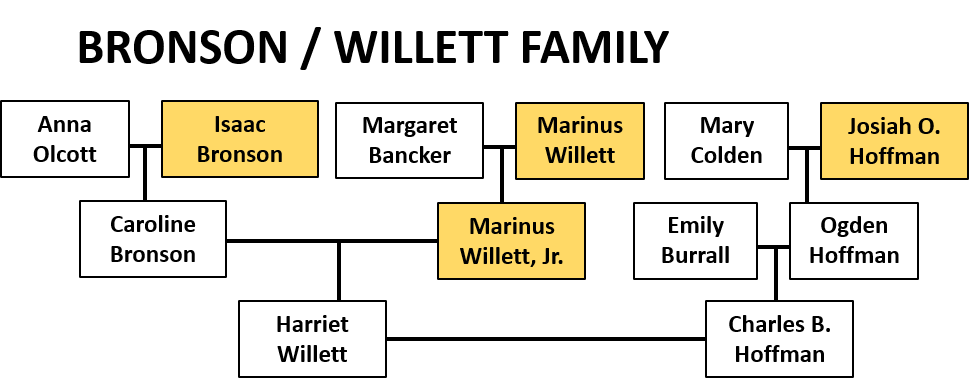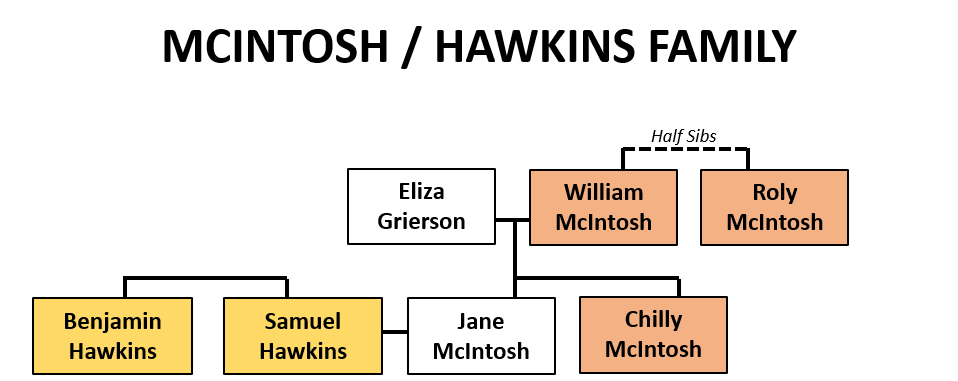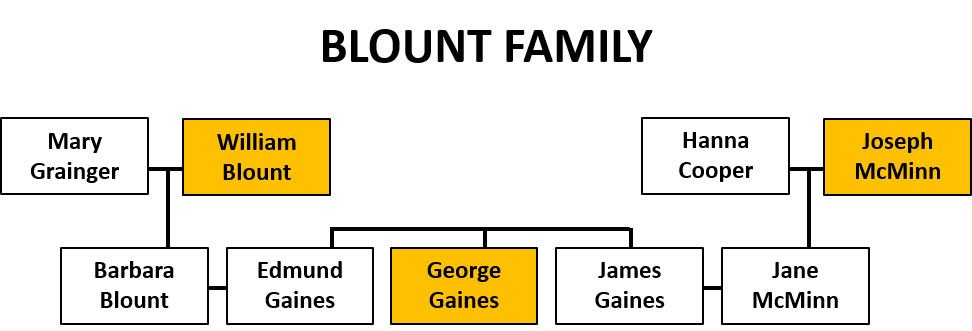Families at the First Treaty

Brothers Thomas and Andrew Lewis were born into one of the most prominent land speculating families in Virginia. (Their father had received a grant of 750,000 acres from the colonial-era governor of Virginia.) They were selected by George Washington, another Virginia land speculator, to serve as commissioners for the first US-Indian treaty, with the Lenape Delaware. They were accompanied at the treaty by their in-laws, the Finleys.
These 4 US signers account for 4 signatures on 1 treaty.

William Crawford was George Washington’s western land agent. As early as 1764 he was locating land for Washington's speculative purchases in violation of the Royal Proclamation of 1763. He was raised with his step-brother John Stephenson in a household that Washington often visited, and the step-brothers were present at the first US-Indian treaty, with the Lenape Delaware in 1778.
These 2 US signers account for 2 signatures on 1 treaty.
Families at New York treaties

Isaac Bronson was a banker and land speculator, one of the 10 richest people in New York City and owner of hundreds of thousands of acres of land. Marinus Willet was a military hero and mayor of New York City. Willet’s treaty-signing son married Bronson’s daughter, and their daughter married into the family of land speculator Joseph Ogden Hoffman, who was Isaac Bronson’s business partner.
These 4 US signers account for 4 signatures on 4 treaties.

Robert Morris, “Financier of the Revolution,” was the richest man in the US when the country was founded. When Oliver Phelps and Nathaniel Gorham went bankrupt trying to acquire the western fifth of New York State, Morris purchased millions of acres from them. Eventually Morris acquired more than 10 million acres of land and 7 thousand lots in Washington, D.C., but the shady financial dealings required to float his speculation sent him to debtor’s prison.
These 2 US signers account for 3 signatures on 2 treaties.

Israel Chapin was one of the founders of Canandaigua, the principle town in the vast Phelps-Gorham purchase of western New York. He was the long-term US agent to the Six Nations, replaced upon his death by his son. His son-in-law Nathaniel Howell became a prominent Canandaigua attorney and state politician. Chapin’s granddaughter married John Greig, who managed millions of acres purchased from Robert Morris.
These 4 US signers account for 8 signatures on 5 treaties.
US/Indigenous families 
Adam Brown was a white child captured by the Wandot, and raised as a member of the nation. Brown fought with the Wyandot and British in wars against the US, and signed treaties as a Wyandot representative. Brownstown, Michigan, site of several US-Indian treaties, was named after him. Brown's grandchildren included Matthew Mudeater, a Wyandot treaty signer who led his nation during their removal to Oklahoma; and Quindaro Nancy Brown, who married US treaty signer Abelard Guthrie. William Walker was captured by the Delaware and transferred to the Wyandot, among whom he was raised by Adam Brown. Walker lived with Brown until he married the Wyandot daughter of US treaty signer James Rankin, and became a US treaty negotiator. William Walker’s children included Wyandot treaty signers John R. Walker and William W. Walker, who became the first provisional governor of Nebraska Territory. These 3 US signers account for 8 signatures on 8 treaties.

John Pitchlynn and Nathaniel Folsom were early immigrants to Creek Country, where they traded, married into prominent Creek families, and raised their children to be leaders of Creek society. Their own activities and those of relatives such as Samuel Mitchell extended their influence among Chickasaw people, as well. Many Pitchlynn and Folsom children signed treaties as Indigenous representatives, and some of these children – particularly Peter Pitchlynn – made personal fortunes at the cultural faultline of US-Indian affairs.
These 5 US signers account for 20 signatures on 14 treaties.

Benjamin Hawkins, a member of the Continental Congress, was appointed by George Washington to be the US Indian agent for all tribes south of the Ohio River. He lived among, and married into the Southeastern tribes. His brother married the daughter of controversial Creek leader William McIntosh, and was assassinated along with McIntosh by Creek factions opposed to their treaty making.
These 2 US signers account for 12 signatures on 12 treaties.

John McDonald and Daniel Ross were Scottish traders who married into a prominent Cherokee family, and operated under trading licenses from Spain. They served as US interpreters at treaties. Ross married McDonald’s daughter, and became the father of John Ross, the long-time Cherokee leader who guided his nation through the Removal Era.
These 2 US signers account for 2 signatures on 1 treaty.

William Wells was captured as a boy and raised by members of the Miami Confederacy, becoming a prominent warrior as the son-in-law of Miami leader Little Turtle. He later became a US Indian agent. His daughters married army officer James Hackley, and William Turner who was a doctor and Indian agent. Hackley and Turner were “Indians when interested and whites when not,” and accumulated land that included the site of Muncie, Indiana. William Well’s nieces married John Ruland who was an Indian subagent for William Clark, and Nathan Heald who was at one point the commandant at Fort Dearborn at the site of Chicago.
These 5 US signers account for 25 signatures on 21 treaties.

Joseph Renshaw Brown was a prominent trader, land speculator and politician in Minnesota. His Dakota Land Company (in which his brother Nathaniel was a partner) founded towns in Minnesota and South Dakota. He married three women who were of Dakota descent, forming connections to prominent families in both Dakota and US societies.
These 5 US signers account for 10 signatures on 5 treaties.

Hercules Dousman was a business partner of Henry Hasting Sibley in the American Fur Company, and owned steamship lines and timberlands. His partner Margaret Campbell was the part-Dakota sister of interpreter Scott Campell, who as a boy accompanied Meriwether Lewis on a trip to the east. Scott’s brothers were also active in the fur trade in the US-Indian Affairs. Scott’s son was acquitted of charges stemming from the Dakota War of 1862.
These 5 US signers account for 18 signatures on 16 treaties.
Kentucky/Tennessee families

William Blount was an inveterate land speculator and one of the most corrupt of all the US treaty signers. As governor of Southwest Territory (which became Tennessee) he acquired millions of acres, often through fraud. Later, as a US Senator from Tennessee, he committed treason in the Chisholm-Romayne conspiracy, trying to mount an illegal attack on Spanish Florida, and was the subject of the first impeachment in US history. Joseph McMinn was the fourth person to serve as Governor of Tennessee. Daughers of both McMinn and Blount married into the prominent Gaines family. Their brother-in-law George Gaines was an Indian agent who superintended Choctaw removal.
These 3 US signers account for 6 signatures on 6 treaties.

Isaac Shelby married a daughter from the Hart family, who were co-purchasers of 20,000,000 acres in Kentucky and Tennessee on the eve of the Revolution. Shelby became the first (and fifth) governor of Kentucky. He and his son signed US-Indian treaties, and his grandson married the sister of John Blair Smith Todd, a first cousin of Mary Todd Lincoln. Todd was a fur trader and land speculator who engineer the Yankton treaty of 1858 in large part to secure his title to the site of Sioux Falls, South Dakota.
These 3 US signers account for 4 signatures on 3 treaties.
Treaty-signing brothers

Clark W. Thompson was a railroad executive and the head of Indian Affairs for the multi-state Northern Superintendency. He acquired 9,000 acres for $1.25 per acre, and sold it for as much as $80 per acre. His brothers worked with him in Indian affairs, and Benjamin chose the harsh site of the Crow Creek reservation for Dakota removal from Minnesota.
These 3 US signers account for 9 signatures on 7 treaties.

Antoine and Nicholas Janis were sons of a French fur trader and a woman, Mary Louise Dany, who was reportedly enslaved by their uncle. The brothers traded for furs, mined for gold and acquired extensive land from the Arapaho.
These 2 US signers account for 2 signatures on 1 treaty.

The Bonga brothers were sons of a fur trader of African descent and an Ojibwe mother. They worked for the American Fur Company, and as interpreters.
These 2 US signers account for 3 signatures on 3 treaties.

Brothers Stephen and Dennis Julien were attached to William Clark’s St. Louis treaty-making machine as interpreters, and members of the Missouri militia. They were fur traders, and Dennis engaged in the shipment of lead.
These 2 US signers account for 9 signatures on 9 treaties.

Ninian Edwards signed 20 treaties as Governor of Illinois Territory, typically as a co-commissioner with Auguste Chouteau and William Clark. The town of Edwardsville, created as a place to register deeds for recently ceded Indigenous land, was named after him. His brother Cyrus also signed four treaties.
These 2 US signers account for24 signatures on 20 treaties.

Henry Schoolcraft was a mineralogist whose exploration of lead deposits in Missouri kicked off the first mineral rush in US history. His fame led to an appointment as Indian agent for Lewis Cass in Michigan Territory. Schoolcraft married Bamewawagezhikaquay (Woman of the Sound the Stars Make Rushing through the Sky), or Jane Johnston. Her stories were passed in corrupted form by Schoolcraft to Henry Wadsworth Longfellow, who corrupted them further in creating Song of Hiawatha. Jane’s brothers were employed as fur traders and as agents in the Indian Affairs bureaucracy that Schoolcraft ran, although they often feuded with Schoolcraft.
These 6 US signers account for 20 signatures on 15 treaties.
Other Families
 The Applegate family joined a wagon train to the Pacific Northwest in the “Great Migration of 1843.” Lindsey Applegate, who had participated in the Black Hawk War in Illinois in the early 1830s, joined an anti-Indian vigilante group. His nephew Albert was born immediately after the family arrived on the coast. The family rose to local political prominence, and Albert’s sister Mary was married to J. W.
Perit Huntington, the Superintendent of Indian Affairs for Oregon. The Applegate family joined a wagon train to the Pacific Northwest in the “Great Migration of 1843.” Lindsey Applegate, who had participated in the Black Hawk War in Illinois in the early 1830s, joined an anti-Indian vigilante group. His nephew Albert was born immediately after the family arrived on the coast. The family rose to local political prominence, and Albert’s sister Mary was married to J. W.
Perit Huntington, the Superintendent of Indian Affairs for Oregon.
These 3 US signers account for 5 signatures on 3 treaties.

Andrew M. Fitch was a circuit-riding preacher and Indian agent in Michigan. His sister married Francis Babbitt, a prominent businessman in Isabella, Michigan who benefited from Fitch’s involvement in Indian Affairs.
These 2 US signers account for 2 signatures on 2 treaties.

The
Grignons were of mixed French, Dakota and Ho Chunk background. They ran trading posts for the American Fur Company in current-day Minnesota and Wisconsin. They acquired thousands of dollars in debt payments (and through their marriages, thousands of acres of land) by participating in treaty making.
These 10 US signers account for 19 signatures on 9 treaties.

Solomon Sibley married the daughter of Ebenezer
Sproat, a principle in the earliest corporation to acquire Indigenous land (in Ohio) from the federal government. Sibley became a Michigan Territorial judge, and owned extensive property in Detroit, sometimes in partnership with Territorial Governor Lewis Cass. His treaty signing sons inherited some of his property, and son Henry went on to wealth and political prominence as a fur trader, land speculator, mine owner and governor of Minnesota. Solomon’s daughter married the personal secretary of Lewis Cass, banker and Indian agent Charles C. Trowbridge.
These 4 US signers account for 15 signatures on 15 treaties.

William Hull was the governor of Michigan Territory at the outbreak of the War of 1812, and surrendered Detroit without mounting a defense of the city. He was sentenced to death for his failure, but his sentence was commuted by the President. Hull’s son was an attorney and aide to his father, who was killed during the War of 1812. Hull’s daughter married Harris Hickman, who became the Territorial attorney general.
These 3 US signers account for 5 signatures on 3 treaties.
| 